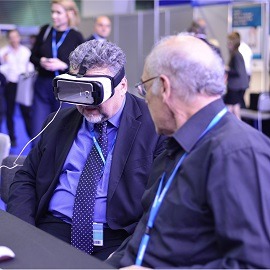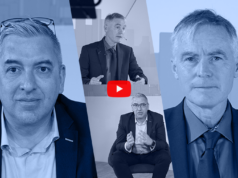 The CX Venous Workshop returned on Wednesday, bigger than ever before. With a new location in the Exhibition Hall and its own series of edited live case presentations, it continues to showcase innovative venous technology and offer delegates the chance to get hands-on with the latest advances in the arena. Expanding from previous years’ Venous Village to this year’s Venous City, the workshop has brought together delegates and demonstrators from all over the world to experience the state of the art.
The CX Venous Workshop returned on Wednesday, bigger than ever before. With a new location in the Exhibition Hall and its own series of edited live case presentations, it continues to showcase innovative venous technology and offer delegates the chance to get hands-on with the latest advances in the arena. Expanding from previous years’ Venous Village to this year’s Venous City, the workshop has brought together delegates and demonstrators from all over the world to experience the state of the art.
Praising the increased size of the Workshop space and the expanded educational schedule, demonstrator Huw Davies (Birmingham, UK) told CX Daily News, “I especially enjoyed the live cases—a good way to get everyone into the session and interested” in the varied workshop stations and technologies. Davies was demonstrating an updated VBox device from Miravas. “The system is an endothermal technique similar to laser and radiofrequency, using heat to seal the vein,” he explained.
Another innovative technology on show yesterday was the Isobar personalised compression garment demonstrated by Charles McCollum (Manchester, UK) and team. The socks are manufactured by the company according to precise 3D scans of patients. “The technology allows us to make a garment to perfectly fit the patient and each of their limbs, and put in exactly prescribed and optimal pressure,” the demonstrators explained. “One can have, in essence, twice as much pressure for half the discomfort.”
The CX Venous Workshop allowed the team to expose their technology—which has applications from the prevention of deep vein thrombosis to the treatment of varicose veins, lymphoedema, leg ulcers and any form of oedema; gravitational or otherwise—to a completely fresh audience of experts. “The technology is new to nearly everybody here,” the Isobar team explained. “What we are trying to achieve is to create partnerships with practitioners—they use the [3D] scanner in their clinics to scan and profile what they would like—the garment, its pressure, its colour and so on—and then we make the garment from there.”
Evi Kalodiki (London, UK) and Christopher Lattimer (London, UK) demonstrated the latest advances in air plethysmography, explaining this years’ research updates. “So far we had been using tip-toe movements to see how blood is pumping in the calf. We have found that weight transference is much more efficient, however, showing that the gold standard is not so gold,” Kalodiki explained. Commenting on the new Venous City environment, she praised the “friendly” environment of the “fantastic” set-up.
“I have been to the CX Venous Workshop several times. It is always fascinating discussing advances with colleagues—not just on the topic chosen for us, but on a whole range of very interesting research. I have had the chance to meet peers from Egypt, from Holland, and from the UK of course, all coming with interesting comments. It is really a congress; we are not just teachers but students with important and often surprising questions,” Albert-Adrien Ramelet (Montcherand, Switzerland) told CX Daily News. “The Workshop helps us bring new messages to our patients back home.”
The faculty bring an international perspective on research and technology to the sessions, Ramelet said, commending the event. Participants can discuss the various subtleties imposed on everyday practise by regulation, by device and drug availability and by patient and physician preference across different countries, he told CX Daily News.
Other innovative technologies showcased at the session include cyrolaser and cryosclerotherapy, the aesthetic phlebology brainchild of Kasuo Miyake (São Paulo, Brazil) which marries augmented reality and laser techniques to enhance the treatment of superficial veins, as well as the virtual reality venous embryology and anatomy educational platform demonstrated by Jean-Francois Uhl (Paris, France).
Today’s Workshop offers delegates even more edited live cases—two in the morning and two in the afternoon—as well as technology stations covering everything from compression bandaging techniques to hands-on tumescent anaesthesia, cannulation and device positioning skills.













